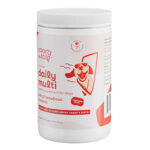Valium for Dogs Outline

Introduction
Valium, also known by its generic name diazepam, is a benzodiazepine medication commonly prescribed to humans for its sedative, anti-anxiety, and muscle relaxant properties. In veterinary medicine, valium is sometimes used to treat dogs with certain medical conditions. However, it’s essential to understand the appropriate use and potential risks associated with valium in dogs.
Uses of Valium in Dogs
Valium is primarily used in dogs for the following conditions:
- Anxiety: Valium can help calm anxious dogs and reduce excessive barking, pacing, and destructive behaviors.
- Seizures: Valium can be used as an adjunct therapy to control seizures in dogs with epilepsy.
- Muscle spasms: Valium’s muscle relaxant properties can alleviate muscle spasms and discomfort.
- Pre-anesthetic medication: Valium can be given to dogs prior to surgery or procedures to reduce anxiety and facilitate sedation.
Dosage and Administration
The dosage of valium for dogs varies depending on the individual animal’s weight, age, and condition being treated. It’s crucial to follow the veterinarian’s specific instructions for dosage and frequency of administration. Valium is typically given orally, in tablet or liquid form.
Side Effects
As with any medication, valium can cause side effects in dogs. These side effects may include:
- Drowsiness: Valium’s sedative properties can cause dogs to become sleepy or lethargic.
- Ataxia: Valium can impair coordination and balance, leading to stumbling or difficulty walking.
- Vomiting: Valium can sometimes cause gastrointestinal distress, including vomiting.
- Difficulty breathing: In rare cases, valium can lead to respiratory depression, especially in dogs with underlying respiratory conditions.
Contraindications and Precautions
Valium should not be used in dogs with:
- Respiratory problems: Dogs with respiratory issues or weakened respiratory systems are at risk for respiratory depression from valium.
- Hepatic or renal disease: Dogs with liver or kidney problems may be unable to metabolize valium properly, leading to toxicity.
- Pregnancy or lactation: Valium can cross the placenta and enter the milk, potentially harming unborn puppies or nursing puppies.
- Concurrent use of other medications: Valium can interact with other medications, such as antidepressants, antipsychotics, and pain relievers.
Withdrawal
Abruptly stopping valium in dogs can lead to withdrawal symptoms, including anxiety, seizures, and tremors. It’s important to gradually wean dogs off valium over a period of time, as directed by the veterinarian.
Conclusion
Valium can be a useful medication for treating certain conditions in dogs when used appropriately under veterinary supervision. However, it’s essential to be aware of the potential side effects, contraindications, and precautions associated with its use. By following the veterinarian’s instructions and closely monitoring the dog for any adverse reactions, valium can effectively alleviate anxiety, control seizures, and reduce muscle spasms in dogs.
Introduction

Introduction
Valium, also known generically as diazepam, is a benzodiazepine medication that has been widely used for decades to treat various medical conditions in both humans and animals. In dogs, valium is primarily used as an anxiolytic (anti-anxiety medication) and sedative. It can be beneficial for managing a wide range of behavioral issues and medical conditions in dogs.
It is crucial to note that valium is a prescription medication and should only be administered under the guidance and supervision of a licensed veterinarian. Self-medicating your dog with valium can have potentially dangerous consequences.
Uses of Valium in Dogs
Valium is commonly used in dogs to treat the following conditions:
- Anxiety: Valium is highly effective in reducing anxiety and fear in dogs. It can be used to treat generalized anxiety disorder, separation anxiety, phobias, and other anxiety-related behaviors.
- Sedation: Valium has sedative properties that can be beneficial for calming dogs during stressful situations, such as car rides, veterinary visits, or thunderstorms.
- Muscle relaxation: Valium can relax muscles, making it useful for treating certain medical conditions that involve muscle spasms or tremors.
- Antiemetics (anti-nausea medication): Valium can help reduce nausea and vomiting in dogs.
Dosage and Administration
The dosage and frequency of valium administration for dogs will vary depending on the individual animal’s age, weight, and medical condition. It is essential to follow the instructions provided by your veterinarian carefully.
Valium is typically administered orally in the form of tablets or liquid. The medication should be given with food to minimize stomach upset.
Side Effects of Valium
Like all medications, valium can have potential side effects in dogs. These side effects may include:
- Drowsiness
- Lethargy
- Ataxia (unsteady gait)
- Confusion
- Increased appetite
- Urinary incontinence
In rare cases, valium can cause more serious side effects, such as respiratory depression or allergic reactions. If you observe any unusual symptoms in your dog after taking valium, contact your veterinarian immediately.
Contraindications
Valium should not be given to dogs with certain medical conditions, including:
- Liver disease
- Kidney disease
- Respiratory problems
- Glaucoma
- Puppies less than 6 months of age
It is important to inform your veterinarian about any other medications or supplements your dog is taking, as there may be potential interactions with valium.
Conclusion
Valium is a valuable medication that can effectively treat a range of behavioral and medical conditions in dogs. However, it is essential to consult with a veterinarian before administering valium to your dog to ensure appropriate dosage, monitoring, and management of potential side effects. By using valium responsibly and under veterinary supervision, you can improve your dog’s quality of life and address anxiety, sedation, and other medical issues effectively.
Indications

Understanding Valium (Diazepam)
Valium, also known generically as diazepam, is a benzodiazepine medication commonly used in veterinary medicine to treat various conditions in dogs. It belongs to a group of drugs known as tranquilizers or anti-anxiety medications, which act on the central nervous system (CNS) to produce a calming and sedative effect.
Indications for Valium in Dogs
Valium is prescribed for a wide range of conditions in dogs, including:
- Anxiety: Valium’s calming effect can help reduce anxiety in dogs experiencing phobias, fear, or environmental stressors.
- Seizures: As an anticonvulsant, Valium can be used to control and prevent seizures in dogs with epilepsy or other seizure disorders.
- Muscle spasms: Valium’s muscle relaxant properties can alleviate muscle spasms and pain associated with conditions like spinal cord injuries, arthritis, or other musculoskeletal issues.
- Pre-operative sedation: Valium can be used to sedate dogs before surgery to reduce anxiety and facilitate the anesthetic process.
- Motion sickness: Valium can help prevent motion sickness and nausea in dogs traveling in vehicles or experiencing other forms of motion.
- Appetite stimulation: In some cases, Valium can stimulate appetite in dogs with poor appetite or eating disorders.
Mechanism of Action
Valium exerts its effects by binding to GABA receptors in the brain and enhancing the inhibitory effects of the neurotransmitter GABA. This results in a decrease in neuronal activity and a calming, sedative effect. Valium also has anticonvulsant and muscle relaxant properties.
Dosage and Administration
The dosage and administration of Valium in dogs will vary depending on the specific condition being treated and the individual patient’s needs. The medication is typically given orally, either as tablets or a liquid suspension. The veterinarian will determine the appropriate dosage and frequency of administration.
Side Effects and Precautions
Valium is generally well-tolerated in dogs, but some side effects may occur, including:
- Sedation: Valium can cause drowsiness and lethargy, especially at higher doses.
- Ataxia: Valium may impair coordination and balance, particularly in elderly or debilitated dogs.
- Gastrointestinal upset: Valium can occasionally cause nausea, vomiting, or diarrhea.
- Respiratory depression: Valium can suppress breathing at high doses or in dogs with respiratory problems.
It is important to follow the veterinarian’s instructions carefully and avoid giving Valium to dogs with known allergies to the drug or other benzodiazepines. Valium can interact with other medications, including sedatives, anesthetics, and certain antibiotics.
Conclusion
Valium is a versatile medication that can provide effective treatment for various conditions in dogs, including anxiety, seizures, muscle spasms, and motion sickness. When used appropriately under veterinary supervision, Valium can improve the quality of life for dogs by reducing symptoms and promoting a sense of well-being. However, it is crucial to be aware of the potential side effects and precautions associated with this medication.
Contraindications

Valium (diazepam) is a benzodiazepine medication commonly used to treat anxiety, seizures, and muscle spasms in dogs. While it can be an effective medication for these conditions, it is important to be aware of the contraindications for its use.
1. Hypersensitivity
Dogs with a known hypersensitivity to valium or other benzodiazepines should not receive the medication. Hypersensitivity reactions can range from mild skin rashes to severe anaphylaxis, a life-threatening allergic reaction.
2. Severe Liver Disease
Valium is metabolized in the liver. In dogs with severe liver disease, the ability to break down and eliminate the medication may be impaired, leading to accumulation and potential toxicity.
3. Severe Respiratory Compromise
Benzodiazepines, including valium, have a depressant effect on the respiratory system. In dogs with severe respiratory compromise, such as pneumonia or severe asthma, valium can further suppress breathing and lead to respiratory failure.
4. Glaucoma
Valium can cause dilation of the pupils, which can lead to increased intraocular pressure. Dogs with glaucoma, a condition characterized by high pressure within the eye, should not receive valium as it can worsen their condition.
5. Pregnancy and Lactation
Valium has been shown to cross the placenta and enter breast milk. It can cause adverse effects in puppies, including sedation, respiratory depression, and skeletal abnormalities. Therefore, valium should not be given to pregnant or lactating dogs.
6. Concurrent Use with Other CNS Depressants
Valium should not be used in combination with other central nervous system (CNS) depressants, such as opioids, barbiturates, or anesthetics. These combinations can potentiate the sedative and respiratory depressant effects of valium, leading to serious complications.
7. Aggressive Behavior
Valium can have a calming effect on most dogs, but in some cases, it can paradoxically cause aggression. This is more likely to occur in dogs with a history of aggressive behavior or those that are anxious or fearful.
8. Obstructive Lung Disease
Valium can relax the muscles in the airway, which may lead to breathing difficulties in dogs with obstructive lung disease, such as chronic bronchitis or emphysema.
9. Gastric Dilation-Volvulus (GDV)
Valium can relax the stomach muscles, increasing the risk of gastric dilation-volvulus (GDV), a life-threatening condition in which the stomach twists on itself.
10. Post-Operative Recovery
Valium should not be used in dogs immediately after surgery, as it can interfere with recovery and delay consciousness.
Conclusion
Valium can be a safe and effective medication for certain conditions in dogs, but it is important to be aware of the potential contraindications. Dogs with any of the above conditions should not receive valium without the careful assessment and supervision of a veterinarian. By understanding these contraindications, veterinarians and dog owners can ensure the safe and appropriate use of valium in dogs.
Dosage

Introduction
Valium, also known as diazepam, is a benzodiazepine medication commonly used in veterinary medicine to treat anxiety, seizures, and muscle spasms in dogs. Determining the appropriate dosage of valium for a dog is crucial to ensure its effectiveness and safety.
Guidelines for Determining Dosage
The dosage of valium for dogs is typically determined based on the following guidelines:
- Weight: The primary factor influencing dosage is the dog’s weight. The standard dose of valium for dogs is 0.5-2 mg per kilogram (0.23-0.91 mg per pound) of body weight.
- Breed: Certain breeds may exhibit increased or decreased sensitivity to valium. For example, sighthounds and some toy breeds may require lower doses, while giant breeds may require higher doses.
- Condition: The underlying condition being treated also influences the dosage. For mild anxiety, a lower dose may be sufficient, while for severe seizures, a higher dose may be necessary.
Influencing Factors
In addition to these guidelines, several other factors can influence the appropriate dosage of valium for a dog:
- Age: Puppies and elderly dogs may require lower doses due to decreased liver and kidney function.
- Health status: Dogs with underlying health conditions, such as liver or kidney disease, may require different doses.
- Other medications: If the dog is taking other medications, the potential for interactions should be considered.
- Individual response: Dogs vary in their sensitivity to valium, so the dosage may need to be adjusted based on the individual’s response.
Determining the Appropriate Dose
To determine the appropriate dose of valium for a dog, consult with your veterinarian. Your veterinarian will consider the dog’s weight, breed, condition, and any other relevant factors to determine the optimal dose.
Administration
Valium is typically administered orally in tablet or liquid form. The medication can be given with or without food, depending on the dog’s individual tolerance. Follow your veterinarian’s instructions carefully for the frequency and duration of administration.
Monitoring and Side Effects
Once valium has been administered, it is important to monitor the dog for any side effects. Common side effects include drowsiness, incoordination, and gastrointestinal upset. If any severe side effects occur, seek veterinary attention immediately.
Overdose
An overdose of valium can be life-threatening in dogs. Symptoms of overdose include severe drowsiness, respiratory depression, and seizures. If you suspect your dog has overdosed on valium, seek emergency veterinary care immediately.
Conclusion
Determining the appropriate dosage of valium for a dog is a critical aspect of veterinary care. By understanding the guidelines and influencing factors, dog owners and veterinarians can work together to provide the best possible treatment for their beloved companions. Always consult with your veterinarian before administering any medication to your dog, and follow their instructions carefully to ensure safety and effectiveness.
Administration
Valium, also known generically as diazepam, is a commonly prescribed medication used to treat a variety of medical conditions in dogs. It belongs to a class of drugs called benzodiazepines, which are known for their calming and anti-anxiety effects. As a pet owner, understanding the proper administration of valium to your dog is crucial to ensuring their safety and well-being.
Methods of Administering Valium to a Dog
Valium can be administered to dogs in several ways:
- Orally: This is the most common method of administration and involves giving the dog a tablet or capsule by mouth. The tablet or capsule can be placed in a small amount of food or hidden in a treat to make it easier for the dog to take.
- Injection: Valium can also be given to dogs through injection, either intravenously (IV) or intramuscularly (IM). This method is typically used in veterinary clinics or emergency situations where rapid medication delivery is required.
- Suppository: Vallium can be administered as a suppository, which is inserted into the dog’s rectum. This method is sometimes used when oral administration is not possible or the dog is vomiting.
Duration of Treatment
The duration of valium treatment for dogs will vary depending on the underlying medical condition being treated. Generally, short-term treatment is recommended to avoid potential side effects. However, in some cases, long-term administration may be necessary for chronic conditions such as anxiety or seizures.
Proper Administration Techniques
To ensure safe and effective administration of valium to your dog:
- Follow your veterinarian’s instructions explicitly: Always consult with your veterinarian before administering valium to your dog. They will determine the appropriate dosage and schedule based on the dog’s individual needs.
- Administer the correct dosage: Giving your dog too much valium can be dangerous. Never exceed the prescribed dosage or administer it more frequently than directed.
- Monitor for side effects: While valium is generally safe for dogs, it can cause side effects such as drowsiness, lethargy, and coordination problems. Contact your veterinarian immediately if you notice any unusual behaviors or changes in your dog’s condition.
- Store the medication securely: Keep valium out of reach of children and other animals. It is a controlled substance and should be stored in a locked cabinet to prevent unauthorized use.
Conclusion
Understanding the proper administration of valium to your dog is essential for responsible pet ownership. By following your veterinarian’s instructions, using the correct methods, and monitoring for potential side effects, you can help ensure that your companion receives the best possible care and well-being while using this medication.
Side Effects
Introduction
Valium (diazepam), a benzodiazepine medication, is commonly prescribed for dogs to alleviate anxiety, seizures, and muscle spasms. While generally safe and effective, it is crucial for pet owners to be aware of potential side effects and the importance of monitoring for adverse reactions.
Potential Side Effects of Valium in Dogs
Like any medication, Valium can have side effects in dogs, including:
- Sedation and drowsiness: Valium’s primary effect is to induce relaxation and sedation. In some cases, dogs may experience excessive drowsiness or lethargy.
- Ataxia and incoordination: Valium can affect a dog’s balance and coordination, leading to unsteady gait or difficulty walking.
- Behavioral changes: Some dogs may exhibit changes in behavior, such as increased anxiety, agitation, or irritability.
- Gastrointestinal upset: Valium can cause nausea, vomiting, diarrhea, or constipation in some dogs.
- Respiratory depression: In high doses or in dogs with pre-existing respiratory problems, Valium can suppress breathing.
Monitoring for Adverse Reactions
It is essential for pet owners to closely monitor their dogs while taking Valium and report any unusual or concerning symptoms to their veterinarian promptly. Some specific signs to watch for include:
- Excessive sedation: If your dog appears excessively sleepy or unresponsive, contact your veterinarian immediately.
- Difficulty breathing: Pay attention to any changes in your dog’s breathing, such as rapid or shallow breathing, or wheezing.
- Behavioral changes: Monitor for any sudden or significant changes in your dog’s behavior, such as aggression, withdrawal, or confusion.
- Gastrointestinal problems: If your dog experiences persistent vomiting, diarrhea, or constipation, it is important to consult your veterinarian.
Managing Side Effects
The best way to manage side effects from Valium is to administer the medication as directed by your veterinarian. Follow the dosage and frequency recommendations carefully, and do not increase or decrease the dosage without consulting your veterinarian.
In some cases, your veterinarian may recommend adjusting the dosage or prescribing an alternative medication if side effects are severe or persistent.
Precautions
Certain dogs may be more susceptible to side effects from Valium, including:
- Puppies or young dogs
- Elderly dogs
- Dogs with liver or kidney disease
- Dogs that are overweight or obese
- Dogs taking other medications that interact with Valium
It is crucial to inform your veterinarian about your dog’s complete medical history and any other medications they are taking to ensure safe and appropriate Valium administration.
Conclusion
Valium can be an effective medication for managing anxiety, seizures, and other conditions in dogs. However, pet owners should be aware of potential side effects and the importance of monitoring their dogs closely for adverse reactions. By working closely with your veterinarian, you can ensure your dog benefits from the therapeutic effects of Valium while minimizing any potential risks.
Interactions
Valium (diazepam) is a benzodiazepine medication commonly prescribed to dogs for managing anxiety, seizures, and muscle spasms. While effective, it is crucial to be aware of potential interactions between Valium and other medications or substances.
Interactions with Other Medications
Valium can interact with several types of medications, including:
- Anticonvulsants: Valium can potentiate the effects of anticonvulsants, such as phenobarbital and levetiracetam, leading to increased drowsiness and sedation.
- Sedatives: Valium should not be combined with other sedatives, such as acepromazine or propofol, as it can further depress the respiratory system and central nervous system.
- Anesthetics: Valium can prolong the effects of anesthetics, increasing the risk of respiratory depression and hypotension.
- Warfarin: Valium may interfere with the metabolism of warfarin, an anticoagulant, leading to an increased risk of bleeding.
- Erythromycin: Erythromycin, an antibiotic, can inhibit the breakdown of Valium in the liver, resulting in higher levels of the medication in the dog’s body.
Interactions with Substances
Valium can also interact with certain substances:
- Alcohol: Combining Valium with alcohol can significantly enhance its sedative effects, leading to life-threatening respiratory depression.
- Grapes and Raisins: These fruits contain toxins that can damage the kidneys in dogs, and Valium can slow the elimination of these toxins from the body.
Importance of Informing the Veterinarian
It is essential to inform your veterinarian about all medications and supplements your dog is taking. This includes prescription drugs, over-the-counter products, and herbal remedies. By providing this information, your veterinarian can assess potential interactions and adjust the dosage or medication choice as needed.
Additional Considerations
- Valium can cause drowsiness and impaired coordination, especially in the initial stages of treatment.
- Monitor your dog closely for any signs of adverse effects, such as vomiting, diarrhea, or lethargy.
- Do not abruptly discontinue Valium, as it can lead to seizures and other withdrawal symptoms.
- Store Valium in a secure location away from children and pets.
Conclusion
Valium is a powerful medication that can effectively manage certain conditions in dogs. However, it is important to be aware of potential interactions with other medications and substances. Always consult with your veterinarian before administering Valium or any other medication to your dog, and provide complete information about all medications and supplements the animal is receiving. By understanding the risks and taking necessary precautions, you can ensure the safe and effective use of Valium for your canine companion.
Precautions
Introduction
Valium, also known generically as diazepam, is a benzodiazepine medication commonly used in veterinary medicine to treat various conditions in dogs, such as anxiety, seizures, and muscle spasms. While it can be an effective treatment, it is crucial for pet owners to be aware of the potential risks and precautions associated with valium use in dogs.
Special Precautions
1. Liver and Kidney Disease:
Valium is metabolized by the liver and excreted by the kidneys. Dogs with liver or kidney disease may have difficulty clearing valium from their bodies, leading to increased risk of side effects. In these patients, lower doses and careful monitoring are essential.
2. Concurrent Medications:
Valium can interact with other medications, including antibiotics, antifungals, and cardiac drugs. Always inform your veterinarian about all medications your dog is taking to avoid potential interactions.
3. Breed Susceptibility:
Certain breeds, such as Scottish Terriers and Bulldogs, are more sensitive to the effects of valium and may require lower doses. It is critical to consult with your veterinarian before giving valium to dogs of these breeds.
4. Puppies and Pregnant/Nursing Dogs:
Valium should be used with caution in puppies and pregnant or nursing dogs. In puppies, the drug may have a more pronounced effect, while in pregnant dogs, it can cross the placenta and affect the developing fetuses.
Potential for Misuse and Addiction
1. Misuse by Humans:
Valium is a controlled substance and can be misused by humans. Keep all medications out of reach of children and others who may not understand the potential dangers.
2. Addiction in Dogs:
While addiction in dogs is rare, it can occur with chronic valium use. Signs of addiction include increased tolerance, escalation of dosage, and withdrawal symptoms when the drug is stopped.
3. Accidental Overdose:
Valium can be fatal if ingested in large quantities. If your dog ingests valium accidentally, seek immediate veterinary attention.
Safe Use Guidelines
To ensure the safe and effective use of valium in dogs, follow these guidelines:
- Prescribe by a Veterinarian: Only give valium to your dog if it has been prescribed by a veterinarian.
- Follow Dosage Instructions: Strictly adhere to the dosage and frequency prescribed by your veterinarian.
- Monitor Your Dog: Observe your dog closely after administering valium to detect any potential side effects.
- Contact Your Veterinarian: Contact your veterinarian immediately if you notice any unusual behaviors or side effects.
- Store Securely: Keep valium away from children and others who may misuse it.
- Dispose Safely: When valium is no longer needed, dispose of it properly according to your veterinarian’s instructions.
Conclusion
Valium can be a valuable medication for treating various conditions in dogs, but it is crucial to use it with caution and follow the prescribed guidelines to minimize risks. By being aware of the potential precautions and risks associated with valium use, dog owners can help ensure the safety and well-being of their furry companions.
Storage
Valium, also known as diazepam, is a benzodiazepine medication commonly prescribed to dogs for anxiety, seizures, and muscle spasms. Ensuring its proper storage is crucial to maintain its effectiveness and prevent potential risks. Here are detailed instructions for storing valium for dogs:
1. Cool, Dry, and Dark Location:
Store valium in a cool, dry, and dark place. Avoid areas exposed to direct sunlight or excessive heat, as these factors can degrade the medication. An ideal storage location is a refrigerator or a cabinet in a cool, well-ventilated room.
2. Original Container:
Keep valium in its original container. The manufacturer’s packaging provides optimal conditions for storage and protects the medication from moisture and light. Do not transfer valium to other containers, as they may not provide the same level of protection.
3. Tightly Sealed Container:
Ensure the valium container is tightly sealed after each use. Moisture can compromise the medication’s effectiveness, so it’s important to prevent air from entering the container.
4. Out of Reach of Pets and Children:
Valium can be harmful if ingested by pets or children. Store it in a secure location that is inaccessible to them. Consider using a lockable cabinet or a high shelf to prevent accidental consumption.
5. Temperature Monitoring:
If you store valium in a refrigerator, check the temperature regularly to ensure it remains within the prescribed range. Most valium formulations should be stored between 36-46°F (2-8°C).
6. Expiration Date Monitoring:
Be aware of the medication’s expiration date and discard any valium that has expired. Expired medications may not be effective and could potentially harm your pet.
7. Disposal of Unused Valium:
If you have any unused valium, do not dispose of it in the trash or by flushing it down the toilet. Consult with your veterinarian or pharmacist for proper disposal instructions. They may recommend returning the medication to their office for safe disposal.
8. Veterinarian Consultation:
Always follow your veterinarian’s instructions for storing valium and any other medications prescribed to your pet. They can provide specific guidance based on the individual needs of your dog.
Additional Precautions:
- Avoid storing valium in damp or humid areas.
- Do not expose valium to extreme temperatures, either high or low.
- Store valium away from strong odors or chemicals that may interact with the medication.
- If you notice any changes in the appearance or smell of the medication, discard it immediately and contact your veterinarian.
Proper storage of valium is essential for its safe and effective use in dogs. By following these guidelines, you can help ensure the medication retains its potency and protects your pet from any potential risks.


















